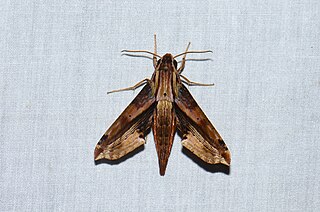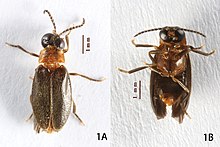
The Lampyridae are a family of insects in the beetle order Coleoptera with more than 2,000 described species. They are soft-bodied beetles that are commonly called fireflies, glowworms, or lightning bugs for their conspicuous use of bioluminescence during twilight to attract mates or prey. Fireflies produce a "cold light", with no infrared or ultraviolet frequencies. This chemically produced light from the lower abdomen may be yellow, green, or pale red, with wavelengths from 510 to 670 nanometers. Some species such as the dimly glowing "blue ghost" of the Eastern U.S. may seem to emit blueish-white light from a distance and in low light conditions, but their glow is bright green when observed up close. Their perceived blue tint may be due to the Purkinje effect.
Phausis is a genus of firefly beetles. These beetles are for the most part unimpressive in their appearance and behaviour, so have not drawn much study, and little is known about many of the species. Species in this genus are at least known from North America. Ten species are described in North America, ranging throughout much of the continent.

Atalopedes campestris is a small grass skipper butterfly. It has a wingspan of 35–41 mm. Male is orange, edged with brown, and has a large brown-black stigma. Female is darker with lighter markings in the center of the wing.

Lampyris noctiluca, the common glow-worm of Europe, is the type species of beetle in the genus Lampyris and the family Lampyridae.

Eupanacra mydon, the common rippled hawkmoth, is a moth of the family Sphingidae.

Macroglossum heliophila, the broad-bordered hummingbird hawkmoth, is a moth of the family Sphingidae. It was described by Jean Baptiste Boisduval in 1875. It is found from north-eastern Sikkim, India across southern China to Cheju Island, southern Japan, Taiwan and the Philippines and then south through Vietnam, Thailand, Malaysia and Indonesia to New Guinea and neighbouring islands. It is also known from Queensland, but doubt in Sri Lanka.

Luciola cruciata, known as "genji-botaru" (ゲンジボタル) in Japanese, is a species of firefly found in Japan. Its habitat is small ditches and streams, and its larvae are aquatic.
Aquatica ficta is a species of firefly found in Taiwan and parts of China. It was formerly placed in the genus Luciola. Its habitat is still water, and the larvae are aquatic.
Aquatica hydrophila is a species of firefly found in Taiwan. Described in 2003, it was formerly placed in the genus Luciola. The larvae are aquatic and live in ditches and small streams.

Aquatica lateralis, known as "heike-botaru" (ヘイケボタル) in Japanese, is a species of firefly found in Russia, Japan and Korea. It was formerly placed in the genus Luciola. The larvae are aquatic and live in rice paddies.
Luciola substriata is a species of firefly found in India, Myanmar, China and Taiwan. The larvae are aquatic and can swim, living in marshes, paddies, lakes and ponds.

Oculogryphus, is an Asian genus of firefly beetles: it has been placed in the Ototretinae or may be considered incertae sedis. The genus contains 4 species. The type species O. fulvus was discovered from Vietnam.
Oculogryphus fulvus, is a species of firefly beetles belonging to the family Lampyridae. It is endemic to Vietnam.
Oculogryphus bicolor, is a species of firefly beetles belonging to the family Lampyridae. It is endemic to Vietnam.
Oculogryphus shuensis, is a species of firefly beetles belonging to the family Lampyridae. It is endemic to China.
Pterotus obscuripennis is a species of firefly in the beetle family Lampyridae. It is found in North America. Adult males are smaller, alate, capable of fight, have an elaborate antenna morphology, and are totally non-luminous. Adult females are larger, fully larviform and flightless, and cream to light golden brown in color, and luminous with photo organs on the seventh and eighth abdominal segment. Larvae are largely black in color, with cream to white coloration in the spaces between the body segements, and are luminous and predatory on slugs.
Hyperstoma is a genus of firefly beetles in the family Lampyridae. Previously considered as a monotypic genus, the second species of the genus was described from 2011. The genus is endemic to Sri Lanka.
Abscondita chinensis, is a species of firefly beetle found in India, China and Sri Lanka.
Abscondita promelaena, is a species of firefly beetle found in India and Sri Lanka.
Harmatelia bilinea, is a species of firefly beetle endemic to Sri Lanka.








